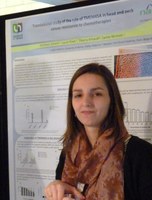Best poster prize for NARILIS PhD student Kathleen Schmit at the 12th meeting of the FRS-FNRS Contact Group on oxidative stress and antioxidants
On April 22nd, Kathleen Schmit participated to the 12th Meeting of the FRS-FNRS Contact Group on "Oxidative Processes and Antioxidants" in Louvain-la-Neuve. During this meeting, she was awarded the Best Poster Prize with her communication entitled "Translational study of the role of TMEM45A in head and neck cancer resistance to chemotherapies" (see abstract below).
ABSTRACT
Translational study of the role of TMEM45A in head and neck cancer resistance to chemotherapies
Kathleen Schmit1, Laure Finet2, Thierry Arnould1, Carine Michiels1
2 Biobank, CHU UCL Dinant Godinne, Avenue Docteur Gaston Thérasse 1 , Yvoir
Successful remission can be achieved with chemotherapy in most cases of cancer but refractory diseases and relapses remain a major obstacle. Multiple processes influence tumor responses to therapies. Recently we developed unique cell models, which were instrumental to demonstrate that tumor microenvironment, and more specifically hypoxia (1% O2), favors tumor growth as well as resistance to treatments. TMEM45A has been identified as a protein whose expression is increased by hypoxia, which displays strong anti-apoptotic properties and which seems to be involved in the resistance of cancer cells to chemotherapeutic drugs. Indeed, when TMEM45A expression was silenced, human hepatocellular carcinoma cells (HepG2) incubated with etoposide under hypoxia became sensitive to the cell death induced by this chemotherapeutic drug. The aim of the project is to pursue the study of the contribution of this protein in modulating the responses to treatment and the mechanisms by which it acts. In order to focus our project on relevant types of cancer, a preliminary screen of TMEM45A expression in human tumor biopsies has been performed and we observed that larynx tumor (head and neck squamous cell carcinoma) displayed the highest level of TMEM45A mRNA expression in comparison to the adjacent healthy tissue. We thus chose two head and neck squamous cell carcinoma cell lines: Cal27 cells that are highly sensitive to cisplatin and SQD9 cells that are resistant to cisplatin. The sensitivity of cancer cells to cisplatin decreases in hypoxic condition evidencing the protective effect of hypoxia. To confirm the involvement of TMEM45A in cell resistance to anti-cancer agents, we invalidated the expression of TMEM45A by two different strategies: a stable invalidation by shRNA using lentivirus strategy and a transitory invalidation by siRNA transfection. Only the SQD9 cells were affected by the silencing of TMEM45A in term of morphology, proliferation and sensitivity to cisplatin. Indeed, large vesicles were observed in the invalidated cells. Furthermore, they were growth-arrested and more sensitive to cisplatin. Knowing that TMEM45A is localized in trans-golgi apparatus, it could be involved in the vesicle processing and a secretion/sequestration pathway may be associated with the development of cisplatin resistance. This hypothesis will be investigated by the detection of fluorescence-labeled drug. All together our first results suggest that the TMEM45A invalidation could lead to cell cycle arrest, a deregulation of vesicle processing and an increase in cell sensitivity to cisplatin. The next step of the project is to pursue the study of the protection mechanism mediated by TMEM45A.
 NAmur Research Institute for LIfe Sciences
NAmur Research Institute for LIfe Sciences


